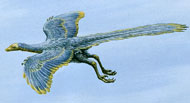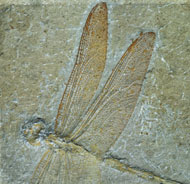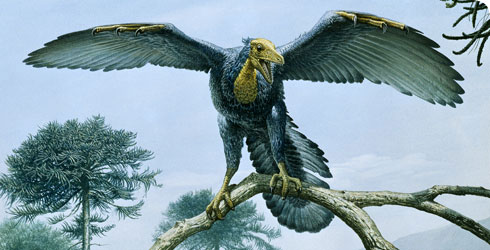Archaeopteryx – a snapshot of evolution in action
Archaeopteryx lived 147 million years ago at the end of the Jurassic Period. The fossils of this extinct animal provide conclusive proof that birds evolved from dinosaurs.

Famous fossil features
Only 10 fossils of Archaeopteryx are known to science but they are extremely well-preserved. They are probably the most famous transitional fossils, showing a combination of dinosaur and bird characteristics that prove modern birds evolved from small meat-eating dinosaurs.
Zoom in to examine Archaeopteryx
What did Archaeopteryx look like?

Archaeopteryx's colouring isn't known, but recent studies suggest some feathers were black. © John Sibbick / Natural History Museum
Archaeopteryx is widely considered to be the earliest known bird. About the size of a magpie, it had wings and feathers very like those of modern birds, a long bony feathered tail, teeth and clawed hands.
The feathers of Archaeopteryx lithographica fossils are preserved as exquisitely detailed impressions. It isn’t possible to determine their colour as there are no actual feather tissues preserved. But recent work on feathers preserved in Chinese dinobird specimens (small feathered dinosaurs) suggests that colours were predominantly black and ginger.
In January 2012, researchers from Brown University in America published a study on the isolated feather generally attributed to Archaeopteryx. According to their analysis of fossilised colour-producing structures called melanosomes, this feather would have been black. However, it is possible that it actually belonged to a different species.
Could Archaeopteryx fly?

Evidence suggests Archaeopteryx could do more than just glide, but wouldn't have been a powerful flapping flyer. © John Sibbick / Natural History Museum
There has been much debate about if and how well Archaeopteryx could fly. A variety of evidence suggests it had some flying ability, including the presence of adaptations for flight on the wing and tail feathers, and the arrangement of the feathers on its wings.
Archaeopteryx’s brain anatomy, which was revealed by CT scanning the 2cm-long braincase present in the Museum’s fossil, indicate that Archaeopteryx probably had a keen sense of sight, and the movement and balance control needed for controlled flight, not just gliding.
However, it would not have been a powerful flapping flyer since it did not have a large breast bone and associated muscles like modern birds.
Where did Archaeopteryx live?
So far, Archaeopteryx fossils have only been found in the Altmühl valley in Bavaria, Germany. All came from lithographic limestone quarries within 15km of each other.
In the Late Jurassic, Europe was much closer to the equator than it is today and Archaeopteryx lived in a warm, subtropical environment.

Part of a fossil dragonfly, Cymatophlebia longialata, from the Jurassic Solnhofen limestone.
The area where the fossils have been found was covered by a shallow and often stagnant coastal lagoon with low vegetation around its edges. The animals must have fallen into the water and then sank slowly into the thick fine-grained mud, where they were preserved in amazing detail.
The Solnhofen limestone is one of the world’s most famous fossil preservations. The lack of oxygen and the rapid sedimentation of very fine particles meant that many delicate features were preserved.
Other beautifully preserved fossils include fishes, crustaceans and starfishes that lived in the lagoon, as well as land animals that were washed in to or fell in to the water, such as lizards, small dinosaurs and pterosaurs. They provide a picture of the Jurassic ecosystem of the area.

